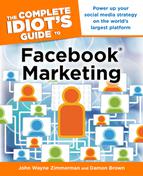Why Facebook Games Matter
Gaming has exploded on Facebook. Here are some 2011 Facebook gaming facts, courtesy of All Facebook:
• 53 percent of all Facebook users play games.
• 69 percent of Facebook gamers are women.
• 56 million users play Facebook games daily.
• 20 percent have paid cash for in-game benefits.
• 50 percent of users log in to Facebook just to play games.
Based on the last fact alone, if you aren’t involved in some type of game, you’re missing literally half of the audience logging in to Facebook.
| FEEDBACK |
If you really want to see how quickly Facebook gaming is ramping up, check out the market evaluations of the gaming companies.
In November 2009, game conglomerate Electronic Arts acquired the Facebook game company Playfish for $400 million—considered a staggering amount at the time. Less than two years later, Playfish competitor Zynga filed for an IPO for $1 billion. In other words, gaming is serious business.
Gamification
So how do Farmville, Mafia Wars, and other strictly fun Facebook games apply to your marketing? If you can get the consumer to want to spend time in your virtual world, you can have a bigger influence on their spending.
There is actually a term for it, too: gamification. Championed by pioneers like Gabe Zichermann, gamification is about using the best traits of gaming to bring the best out of your company’s interactions with customers.
| DEFINITION |
Gamification is the process of taking video-game-related play systems and applying them to nongame environments.
As a classic example, think about Pepsi holding a summer vacation contest: buy a 20-oz. Pepsi, twist off the top, and see if you won! When you think about it, this is the gamification of selling soda. You might not buy a soda to win, but if you are choosing between Coke and Pepsi, it might prompt you to choose Pepsi.
The Pepsi example isn’t related to Facebook, of course—or is it? The traditional soda sweepstakes contest has actually evolved, too, and we can use it to see how the internet is making gamification even more common. About a decade ago, soda manufacturers didn’t just require you to buy the soda, but they gave you a code underneath the cap that had to be plugged into a website. The website, naturally, was of the manufacturer. They got you to buy their soda and visit their website—more than likely for nothing.
Today, marketers are going well beyond codes and websites. For instance, last summer Pepsi began putting QR codes onto its bottles. Scan the QR code using your smartphone and the phone browser opens up a special Pepsi Facebook page. It was an excellent way to get people onto its Facebook page.
| DEFINITION |
QR codes are square symbols that, when viewed by a special scanner, open up a webpage or image on a device. There are dedicated QR scanners, but most computers and smartphones have free QR code software that can scan the symbol.
Reaching Your Market
Pepsi Co. and other manufacturers definitely go after the younger demographic, but adults and older people definitely drink soda, too. What if you have something more narrowly focused?
Assuming you aren’t selling soda, you need to determine your market before attempting to gamify your business. If you don’t know your market precisely, you can’t make an effective outreach plan.
For instance, if you’re going after the retired AARP audience, you might consider creating a Sudoku-style game. The number-puzzle game has really taken off among older and retired people, which means that it’s an excellent way to reach that audience. Creating an overcomplicated game mechanism may frustrate older gamers who didn’t grow up playing video games, and a reflex-based system may be too hard for older hands.
